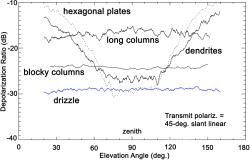Ground-based Remote Icing Detection System: GRIDSIcing is a weather hazard that occasionally causes aviation disasters, especially in winter. In-flight icing forms on wings and other exposed surfaces as an aircraft flies though clouds that contain supercooled liquid water droplets. Larger, drizzle-size drops are particularly hazardous, but ice crystals and snowflakes are not an icing threat. We have designed and are now building a new ground-based cloud radar and radiometer system to monitor clouds in the vicinity of airports and provide automated warnings of icing conditions aloft: The Ground-based Remote Icing Detection System (GRIDS). The GRIDS radar employs radar polarization techniques to recognize regions of cloud that are predominantly composed of water droplets and distinguish them from cloud regions that are predominantly ice crystals. These identifying radar polarization "signatures" rely on the information about particle shape that is contained in the depolarization ratio measured by the radar. Observed depolarization ratios are matched to the theoretical values expected from various cloud particle types to make the identification. Based on several years of research, signatures of numerous crystal types and droplets have been verified by in situ cloud sampling by aircraft, as shown in this figure. The microwave radiometer permits the measurement of the total amount
Putting It All TogetherBuilding on the lessons of more than one decade of experimentation, GRIDS will use the polarization techniques to identify the presence of water drops and crystals. The heart of GRIDS is an ultra-high sensitivity, dual-polarization, millimeter-wave radar capable of detecting extremely weak cloud echoes. A microwave radiometer will quantify the amount of liquid water present aloft and assist with identifications in regions of ice and liquid mixtures. Temperature profile information will be obtained from recent nearby radiosondes or from numerical weather models. Combining these data, the unattended GRIDS will provide automated, simple but informative warning displays for the aviation community every two minutes. The GRIDS project is substantially sponsored by the Federal Aviation Administration's Aviation Weather Research Program. An initiative is also under consideration by the National Weather Service, that will employ GRIDS to improve their models that predict icing conditions and as a benchmark for other icing detection tools.
References | |||

